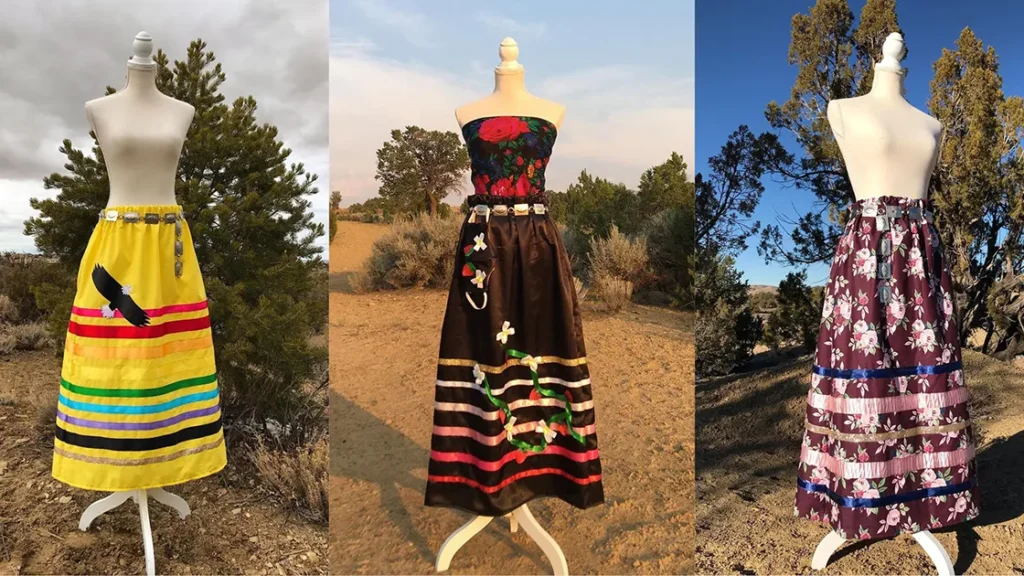
Introduction
Ribbon skirts have long held a sacred place in Indigenous cultures across North America, symbolizing identity, resilience, and a connection to one’s heritage. These skirts, adorned with vibrant ribbons, represent more than just attire; they are wearable narratives, deeply rooted in history and tradition. Today, ribbon skirts are experiencing a renaissance, blending cultural significance with contemporary fashion, empowering Indigenous communities, and sharing their stories with the world.
The Origins of Ribbon Skirts
The history of ribbon skirts traces back centuries, with French traders introducing silk ribbons to Indigenous communities in the Great Lakes region during the 18th century. These ribbons were soon integrated into traditional clothing, evolving into intricate designs that carried unique meanings. The craft was often passed down within families, with each skirt telling a story of its wearer, their lineage, and their community.
Key Historical Influences:
- European Trade: Introduction of ribbons and fabrics expanded design possibilities.
- Community Traditions: Variations in ribbon placement and color patterns reflect regional and familial distinctions.
- Sacred Use: Historically reserved for ceremonies, these skirts embody spirituality and cultural identity.
Ribbon Skirts in Modern Times
In recent years, ribbon skirts have transcended their ceremonial origins to become everyday symbols of pride and empowerment. Indigenous designers like Alyssia Sutherland have reimagined these garments, integrating modern aesthetics while honoring traditional craftsmanship.
The Rise of Everyday Ribbon Skirts
- Empowerment Through Fashion: Ribbon skirts serve as a declaration of identity and strength.
- Cultural Visibility: Increased representation in urban and non-ceremonial contexts highlights Indigenous heritage.
- Modern Designers: Brands such as Ally’s Ribbons are blending traditional designs with contemporary fashion.
National Ribbon Skirt Day: A Turning Point
The first National Ribbon Skirt Day, celebrated on January 4, 2023, marked a significant milestone in recognizing the cultural importance of ribbon skirts. Inspired by Isabella Kulak, a young girl who faced criticism for wearing a ribbon skirt to school, this day serves as a reminder of the resilience and beauty of Indigenous traditions.
Impact of National Ribbon Skirt Day
- Cultural Awareness: Broader understanding of the significance of ribbon skirts.
- Youth Empowerment: Encouraging young individuals to embrace and celebrate their heritage.
- Community Celebrations: Events such as fashion shows and workshops strengthen cultural bonds.
The Craftsmanship Behind Ribbon Skirts
Creating a ribbon skirt is a labor-intensive process that requires skill, patience, and creativity. Each skirt is a unique masterpiece, with the choice of colors, patterns, and ribbons reflecting the wearer’s personal story or spiritual journey.
Steps in Crafting a Ribbon Skirt
- Material Selection: Fabrics and ribbons are chosen for their color symbolism and texture.
- Design Planning: Patterns are sketched to incorporate traditional and personal elements.
- Sewing and Assembly: Precision and care are essential in sewing the ribbons onto the skirt.
- Final Embellishments: Additional details such as beadwork or embroidery enhance the design.
Empowering Youth Through Ribbon Skirts
Programs like the Peguis First Nation fashion show demonstrate the transformative power of ribbon skirts. By teaching youth how to craft their own skirts, communities instill a sense of pride, creativity, and cultural connection.
Benefits of Youth Involvement
- Skill Development: Learning sewing and design techniques.
- Cultural Connection: Deepening ties to ancestral traditions.
- Confidence Building: Wearing self-made skirts fosters self-esteem and pride.
Ribbon Skirts as a Global Movement
From local community gatherings to international events like the Cannes Indigenous Arts and Fashion Festival, ribbon skirts are gaining global attention. These platforms celebrate the artistry of Indigenous designers and bring awareness to the rich cultural heritage they represent.
Prominent Figures in Ribbon Skirt Advocacy
- Alyssia Sutherland: Founder of Ally’s Ribbons, promoting daily wear of ribbon skirts.
- Ashley Callingbull: A notable figure showcasing Indigenous fashion on global stages.
- Youth Designers: Emerging talents bringing fresh perspectives to traditional designs.
Conclusion
Ribbon skirts are more than just garments; they are vibrant symbols of identity, resilience, and cultural pride. As these skirts continue to evolve, they bridge the gap between tradition and modernity, empowering Indigenous communities and sharing their stories with the world. The resurgence of ribbon skirts reflects a broader movement towards honoring and celebrating Indigenous heritage, ensuring that these timeless traditions thrive for generations to come.
